| THEME | NEWSBEAT | WAR OF THE WORLDS |
| Curran | James Curran writes about the ideas that underpin The Liberal Free Press, but much can apply to transformation of Public Sphere (Habermas) which in turn connects to ethos of PSB | James Curran writes about the ideas that underpin The Liberal Free Press, but much can apply to transformation of Public Sphere (Habermas) which in turn connects to ethos of PSB |
| OWNERSHIP | BBC, (PUBLIC SERVICE BROADCASTING) GOVERNMENT, BBC BOARD (TRUSTEES) DIRECT GENERAL , FIRST BEING (LORD RITHE),MULTIMEDIA, CROSS MEDIA, TRANSNATIONAL TRANSGLOBAL, NOT A MONOPOLY, THERE IS A CONCENTRATION OF OWNERSHIP SMALL NUMBER OF FANS WHO OWN TV AND RADIO EVEN THOUGH THEIR ARE A LOT OF DIFFERENT STATIONS. I THINK THE BBC COMES FROM A LEFT WING LIBERTARIAN IDEOLOGY. | PRIVATE COMPANY, TRANSNATIONAL, IT IS AN EXAMPLE OF CONCENTRATION OF OWNERSHIP E.G. A COUPLE OF COMPANYS THAN OWN A COUPLE OF CARTERS. VERTICAL AND HORIZONTAL INTERGRATION |
| HABERMAS | TRANFORMATION OF THE PUBLIC SPHERE, MEDIA IS CONSTANTLY CHANGING WITH THE BBC KEEPING UP. BBC INTENTIONS TO ENSHRINED IN THEIR ETHOS TO INFORM, ENTERTAIN AND EDUCATE. DOESN’T MAKE A PROFIT. THEY PUT SOME MONEY BACK INTO THE PROGRAMME AS HABERMAS EXPLAINS THE NOTION OF TRANSFORMING THE PUBLIC. IT IS PATERNALISTIC. | PRIVATE BUSINESS’S ARE AIMED AT MAKING A PROFIT. THEY TEND TO CARE MORE ABOUT PROFIT RATHER THAN THE PUBLIC SO THEY ARE MORE CONCERNED WITH ENTERTAINMENT THAN EDUCATION. COMMERCIAL ETHOS IS NOT IN THE SPIRIT OF HABERMAS. |
| CHOMSKY | CHOMSKY TEACHES THE CAPACITY TO LEARN AND USE LANGAUGES AS THEIR ARE STRENGTHS AS HUMANS GROW AND DEVELEOP WHICH LINKS WITH NEWSBEAT AS THEY ARE TRYING TO ENTERTAIN BUT INFORMING THE AUDIENCE FOR THEIR OWN BENEFIT. | FOR THE WAR OF THE WORLDS THEY ARE INFORMING THE AUDIENCE TO MUCH WITH KNOWLEDGE OF WHAT IS HAPPENING RATHER THAN ENTERTAINING THEM. THIS IS BECAUSE DIFFERENT PEOPLE HAVE DIFFERENT LANGUAGE UPON OTHERS AND FIND IT EASIER TO REACT CALMLY AND DISTUINGISH WHAT IS TRUE OR NOT. THIS IS KNOWN AS UNIVERSAL GRAMMER. |
| REGULATION | OFCOM, BBC CHARTER GOVERNED BY PARLIAMENT , LICENSE FEE REGULATES BBC AS WELL. BBC/PSB ETHOS TO ENTERTAIN, TO INFORM AND TO EDUCATE (REITH), NEW TECHNOLOGY MEANS BBC FACES MORE COMPETETION. | FEDREAL COMMUNICATIONS COMMISSION AS REGULATOR FOR PRIAVTE BUSINESS WHICH IS NOT REALLY IN THE PUBLIC INTERESTS. |
| AUDIENCE (ACTIVE/PASSIVE) | Lasswell hyperdermic model, how messages are encoded. People getting increasingly passive and lack of reading amounts to newsbeat using specific methods to cater towards a younger audience/lesser intelligence; ie star guests and games- no complicated words Newsbeat encouraging active ‘uses and gratification’ model personal needs escapism, entertainment, self esteem and social needs. information, knowledge about the world, connecting with family, friends and community | Newspaper and Radio in direct competition for the decade, panic is suggested to have been caused by the newspapers rather than the actual radio broadcast showing the passiveness on media consumption ie; 98% were on different station while other 2% knew it wasn’t real- source from RadioLab war of the world broadcast. No accurate answer to weather panic was caused or not- diminishment of habermasses public sphere. The hypodermic needle theory suggests a media text can have a powerful and immediate effect on the passive audience. It would seem “The War of the Worlds” production supports this argument because so many terrified listeners, for example, “rushed out of their houses” to escape the “gas raid”.4 |
| AUDIENCE (LAZARSFELD) | 2 step flow / opinion leaders how we gravitate to people who share the same ideas as ourselves. So the BBC is an unbiased, informed opinion leader (ie BBC Charter focus on impartiality, accurate, true) | opiniion leaders- auson wells, brought on the show to compete with the newspapers, but unlike the bbc who used will and kate to share mental heath issues for the good of the people and society, CBS used this strategy to generate income rather than benifit the public but themselves. |
| AUDIENCE (GUERBNER) | Gerbners cultivation theory more specifically in the sub section called mean world index describes the more consumption of negative media we consume the more negative we see the world- therefore through cultural setting we can use this as an argument to suggest their was panic as the negative in the world such as war and discrimination could’ve manifested and reinforced their belief of something catastrophic actually occurring during the time. | |
| NEW TECHNOLOGY | New technology poses a threat for the bbc as through time and newer technology us as a society is becoming increasingly passive, emergence of short videos have lowered our attention span and therefore the younger emerging audience is too uninterested to listen to a longer news production or story- therefore bbc newsbeat produces cross media available at any time catering towards a younger mind to draw in viewers at any time. | New technology at the tame was the emergence of radio, newspapers and radio were in direct competition for the decade during the gloden age of radio- therefore suggesting as to why newspaper could’ve created panic to almost try and sabotage radio by creating a negative reaction. Radio transformed space as provided news and live audios from all around the world, which also started diminishing habermases public sphere theory as people started writing less and having more trust in a broadcast service- overtrusting for reliability in media products could’ve lead to the increasingly passive audience we have become today, however during the time since it was so new we can associate with Lasswell and Shannon and weaver, how noise and disruption from still a relatively active audience can create a difference encoding from the desired one. |
| CROSS MEDIA CONVERGENCE |
All posts by Roisin Flynn
Filters
war of the worlds
Facts and Figures:
- The War of the Worlds was an episode of the radio series “The Mercury Theatre on the Air”, this was a radio series of live dramas which were created and hosted by Orson Welles in the United States and was originally released on July 11th to December 4th 1938.
- “The War of the Worlds” was specifically a Halloween radio episode which was performed and broadcasted live at 8pm until 9pm on October 30th 1938 and ran for 60 minutes (1 hour).
- “The War of the Worlds” episode instigated panic by convincing members of the public that specific events were taking place such as a Martian invasion although the episode only had few listeners so this did not become a global panic.
- According to Wikipedia, 6 million people heard the episode and caused 1.2 million to be frightened and disturbed. Although 30 minutes into the show before its first break, people still believed this.
Media Institutions:
- The episode was broadcasted over the CBS (Columbia Broadcasting company Radio Network. This radio network provided news to more than 1,000 radio stations throughout the United States and is owned by Paramount Global. CBS Radio was launched in 1927.
NewsBeat csp 1
Exclusive music news, big interviews, entertainment, social media trends and video from the news people at BBC Radio 1 and 1Xtra.
12:45 everyday
Newsbeat is the BBC‘s radio news programme broadcast on Radio 1, 1Xtra and Asian Network. Newsbeat is produced by BBC News but differs from the BBC’s other news programmes in its remit to provide news tailored for a specifically younger audience of teenagers and early twentysomethings
BBC Radio 1’s remit as a public service broadcaster meant it had to broadcast news. Newsbeat was launched on 10 September 1973 in response to the launch of a network of commercial radio stations across the UK which supplied a news service very different from the style of traditional BBC News.
Newsbeat is an example of a transitional media product which reflects changes in the contemporary media landscape. Newsbeat is both a traditional radio programme with regular, scheduled broadcast times, but it is also available online after broadcast.
The broadcast itself and the use of digital platforms provides opportunities for audience interaction. Newsbeat also exemplifies the challenges facing the BBC as a public service broadcaster that needs to appeal to a youth audience within a competitive media landscape.
The BBC = Largest PSB cooperation in the UK
Their ethos is to provide “impartial, high-quality and distinctive output and services which inform, educate and entertain”
Cecil Lewis- ”opening up the world to people”.
- It has been broadcasting since 1973
- ‘Newsbeat promises its younger listeners all the news they need to know from the UK and around the world‘
- The main fifteen-minute Newsbeat programmes are transmitted live over digital audio broadcast (DAB) frequencies at 12:45 and 17:45 during most weekdays. The broadcasts can also be listen to, on demand, through the BBC Sounds app or BBC website. This encourages a younger audience who would most likely view content online, on a mobile device.
potential questions:
how does the newsbeat inform educate and educate
10 facts:
- • Newsbeat as a BBC News product with bulletins are broadcast on BBC Radio 1, BBC Radio 1 Xtra and BBC Asian Network
- • The funding of BBC Radio through the license fee, concept of hypothecated tax
- • Issues around the role of a public service broadcaster within a competitive, contemporary media landscape
- • The distinctive nature of the programme connected to its public service remit
- • Arguments on the need for addressing a youth audience already catered for commercially
- • The influence of new technology on media industries – Newsbeat as multi–platform media product. eg
- o Website
- o Twitter
- o Instagram
- • The regulation of the BBC via Ofcom and the governance of the
- BBC
• The techniques the broadcast uses to target a youth audience and create audience appeal, eg
o Presentation style
o News values
o Content selection
• The opportunities for audience interaction, participation and self-representation
• The way external factors – such as demographics and psychographics – are likely to also affect audience response and produce differing interpretations
• Cultivation theory including Gerbner
• Reception theory including Hall
argue that due to new technologys bbc introduce new concepts to newsbeat as people dont listen to radio as much
public service broadcast
lord wreath- bbc to have an ethos (belief )
entertain inform and education- bbc ethos
BBC charter- to oversee them.
populism- giving the people what they want
- bbc allows for shared opinions and beliefes from he spread of knowledge and news..
- habermans (transformation of the public shpere)- allows people to transform space and time, by interacting with people hundres of miles away at the same time.
quote from seaton–
” i am free to say anything i want, except the one thing i do want to say then i am not free.. in broadcasting a single prohibition emposed on a nation broadcasting authority or within it tends to corode the whole output. – meaning that broadcasters are ‘free’ to say what they want, through their rights but additionally if they speak their opinion that the government or people don’t agree with, then they will be heavily critised.
-choice- ‘real choices offered to consumers by a more effective market”.
james curren quotes
” the radical press with spread their agenda to effect political press”
” profit driven motives take precvidence”
”twin forces of creativity and business”’
BBC- paternalism approach- the policy or practice on the part of people in authority of restricting the freedom and responsibilities of those subordinate to or otherwise dependent on them in their supposed interest. ( restricting people with good intentions nut can have negative consequences.)
– grace winden goldie- noting the most significant thing about broadcasting changes the ideology of time and space. life was lived in the present but with new technology allows us to listen and watch a moment in time whenever you want even the moment its happening
the way in which the bbc became social cement everyone and British culture was centred around the bbc.
broadcasting- to a broad amount of people- mass media, large audience.
narrow casting- niche group.
Press:
convincing acting-
character development-
writing quality-
sound prodcution-
camera quality-
set-
lighting quality-
editing-
oh comely

1- Oh Comely is a magazine that makes people smile, full of quiet moments and stories
2 – it makes people feel better about themselves the way they are
3- launched in 2010
4 – publishes 6 issues a year
5- laust issue was September 2021 due to the pandemic
6 – owned by ice berg press
7 – CEO if iceberg press is Patrick Tembo
-In Oh Comely, there is a radical and apposed representation of women, following ideas of Stuart Hall’s theory on the 3 categories of media representation, it empowers them and not sexualising them like most mass media products such as Men’s Health.
-Steve Neal- repertoire of elements, similarity and differences.
Introduction. Launched in 2010, “Oh Comely” was published by the “proudly independent” Iceberg Press. According to their website, it was a “mindful magazine with a fresh perspective”. Each issue was available to purchase for £5 in a few newsagents, independent retailers, cafes and museums.
– magazine focuses on the non sexualisation of women and representation of women being strong and successful, instead of the reactionary representation of women being overly sexualised by the clothing they wear and other stereotypical hobbies or interests the media think women will be interested in and information they need to know according to powerful producers.
– instead of society’s invisionment of women and according to the medias history of making women dependant on men, and presuming they all wear pink and are housewives, Oh Comely wants to represent women in a completely different way and change society’s beliefs.
theorists-

– This image of ‘undressed women’ in a magazine isn’t rare as many magazines in the media industry projected women in such circumstances where they are partially naked and venerable to the viewer looking ‘sexy’ or ‘seductive’.
– This radical image of a women who is ‘obese’ compared to other women displayed in other magazines in such a manner displays what this magazine wants to create, a healthy loving space for every women who may not be accepted in society’s view of ‘normal’ or a ‘attractive’ women to be appreciated and celebrated.
– The display of her curves and brightly coloured hair goes against all of society’s invisionment of a ‘women’. Having a skinny waste and blonde/brown hair. If the magazine published a ‘normalised’ white girl, it wouldn’t be question, but due to the nature of this magazine, the key notion is to display women in real life, not photoshopped and in a unrealistic environment like the top of the Eiffel tower or walking on water.
theorists-

– On this page it displays a middle eastern or Hispanic women who is the CEO of a tech company. The stigma around women of colour in the media compared to white women is shown by the choice of actors, presenters and models. As the subject of inclusivity increases in modern media and the aim of introducing all ethnic minorities into the spotlight, it has become less of an issue of all white casts. But this magazine is furthermore highlighting how important it is to involve everybody regardless of their differences.
Mens Health analysis
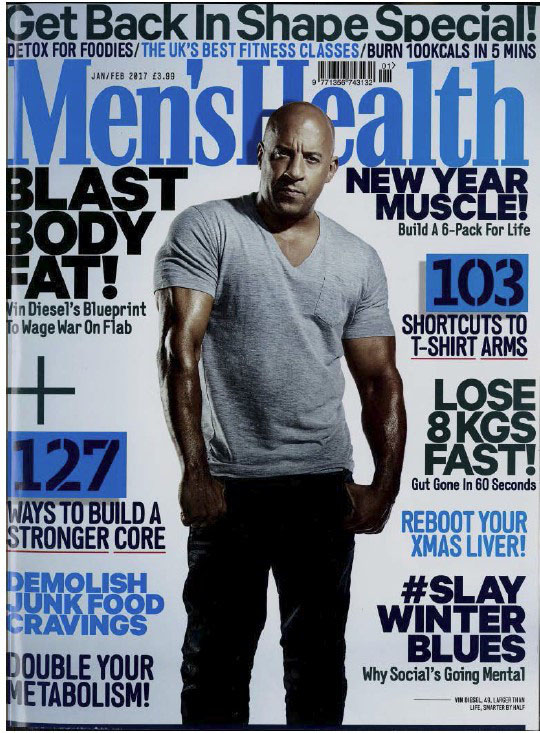

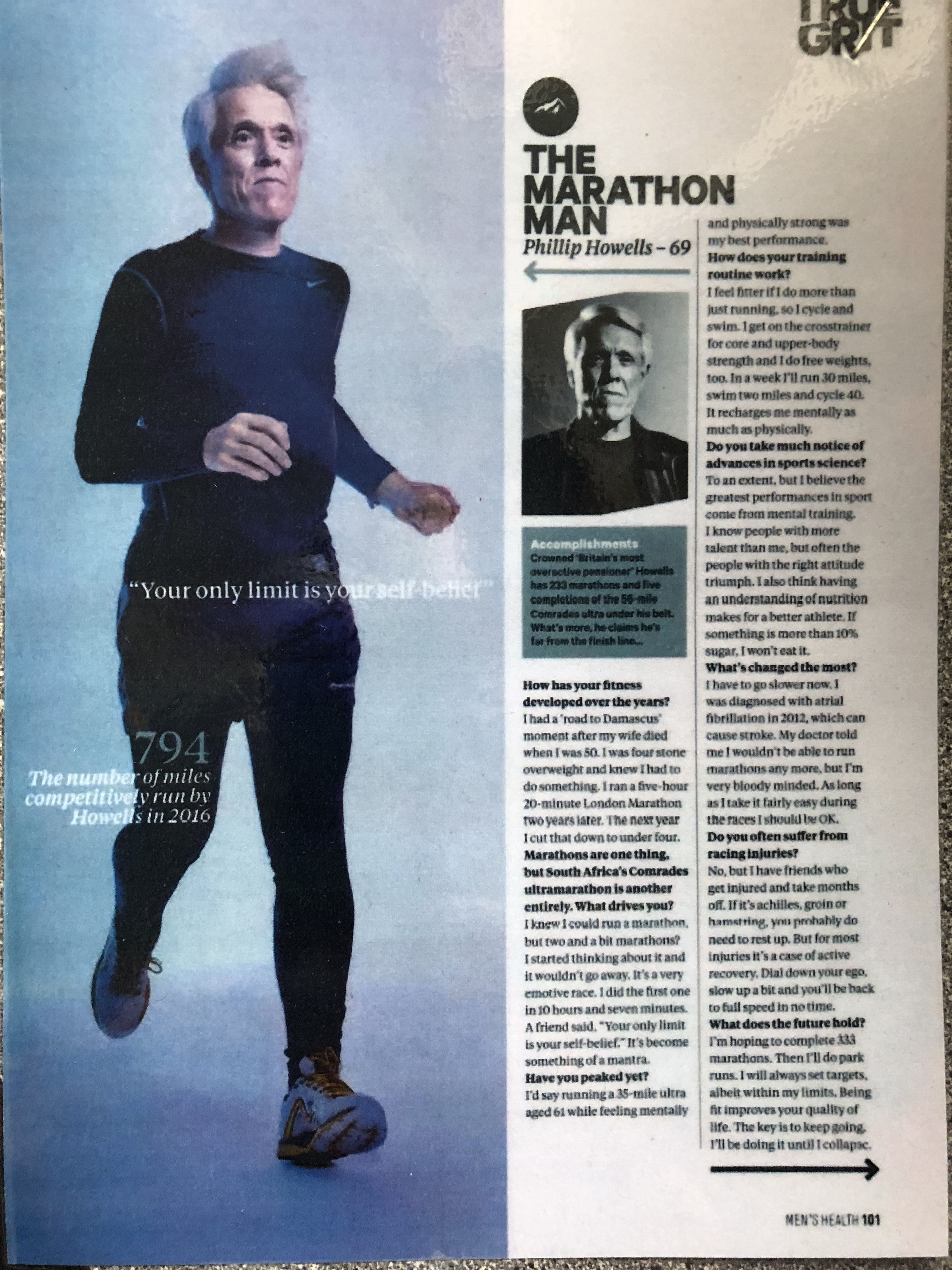

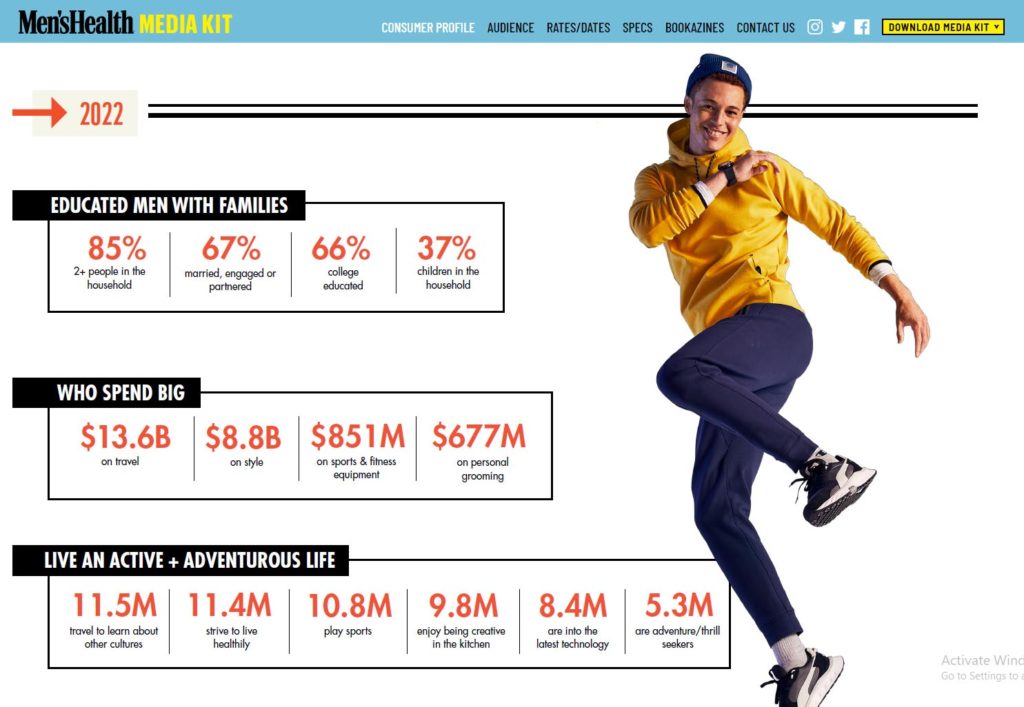
The front magazine page suggest that the anchorage which is the picture of the male figure is linked with the header as it means ‘MENS HEALTH’ a way to which help the male audience to tag along and read more on how to look like the front male figure on the page.
–
Semiotics
Representation – straight ‘alpha male’ men is reactionary. reinforces the idea that men need to be powerful and strong.
– Media language
“get back in shape special” Use of capital letters, exclamation points, colours blue and black stereotypically appealing to men, dialogue “true grit” of men’s wants and desires for their body – all are signifiers to men.
“Best fitness classes for men” – target audience is undoubtedly is for men.
”103 shortcuts to tee shirt arms”, this is a male ‘want’ to aspire to look like Vin Diesel, as his body type is typically what a dream body for a man is, alike skinny arms and a slim waist for women.
Steve Neal says that audience targeting that genres create an appeal for specific audience segments for example to attract the male audience they want something to be portrayed to make them seem powerful and strong to make all of their masculine traits come out.
onimatopia and alliteration.
David g- 4 personality types
- constructed identity- words such as ”muscle, smash, demolish”, construct a typical male identity.
The school of life… thus supporting gauntlets notion of fluid, negotiated, constructive identity.
For example, on page 24 it displays a man topless doing exercise, he is seamlessly lifting weights without any struggle which a ‘warm man’ would display.
key facts on men’s health:
- circulation analysis:
- Joined ABC: 12 April 1995
- Owner: Hearst UK
- ABC Status: Registered
- Reporting Frequency: 12 Monthly (Jan to Dec)
- Standards: Consumer Magazines
- Area: Men’s Lifestyle: General
- 27,871 bought copies in one year
- 66,428 subscription copies in one year
- 1,174 free copies in one year
- 23,077 digital copies bought in one year
Hearst company (parent company) is a conglomerate- owns company’s such as:
–Hearst owns newspapers, magazines, television channels, and television stations, including the San Francisco Chronicle, the Houston Chronicle, Cosmopolitan and Esquire
-Men’s health
-ELLE
-country living
-cosmopolitan
-women’s health
-runners world
– Monthly reach of Men’s Health magazine in the United Kingdom from April 2019 to March 2020, by demographic group.
15+ –1,819
Men- 708
women- 365
adults 15-34- 519
adults 35+ –554
households with children- 391
- Men’s Health magazine had an average monthly reach of around 1.8 million individuals in the United Kingdom from April 2019 to March 2020. Reach was lower among households with children, with 391 thousand readers from this demographic reached by the print title or its website during this period.
To feature in Men’s health:
full page- $205,065 dollars
2/3 page- $159,995
1/2 page- $127,145
1/3 page-$88,180
second cover- $246.080
third cover- $237,880
fourth cover- $268,640
Laswell’s model
–who(sender)
-Hearst communications (parent company)
-Morgan Rees
-says what(message)
-media pack (unique strategies men’s health use to get people to buy and read)
-”professional men to get control of their mental and physical lives”
-Channel(medium)
-online (web portal)
-social media
-To whom(receiver)
-men interested in fitness and health
-Educated men
-family men
-college educated
–With What Effect.
-Making people more healthy
-more happy men in the country
key facts for exam:
dominant signifier – Vin diesel on the front cover of the magazine
dominant ideology – Body image
reactionary representation – A heterosexual man and what society expects on him.
negative stereotype – this creates a negative stereotype to men having to be seen as strong and loose weight
The blue background is associated with male stereotypes, a traditional boy colour
Laswell’s module:
Sender – Men’s health’s is one of the largest men’s magazine and is aimed mainly at “manly” men
Says What – The brand of the magazine called ‘Men’s Health’ aimed for active men who want a better control on their physique / appearance to impress society.
What Channel – Men’s health is a print lifestyle magazine and can also be accessed on their website and social media.
To Whom – Aimed at men who are ‘sporty’ or active. If a man wants motivation to get into shape then the magazine provides information on loosing weight to get that ‘perfect body’
What Effect – Selling the magazine to their target audience through shops, website or social media.
CS Peirce:
Iconic sign – The bold text tells you what you can find inside of this magazine issue. It all relates to loosing weight fast.
Indexical signs – The only image is the dominant signifier placed right in the middle. The muscles relates to the text and the magazine.
Symbolic sign – The magazines colour theme is mostly blue which is seen as a stereotypical colour for men, influences them to buy the magazine. Big bold texts all about loosing weight “demolish junk food cravings” and “Blast body fat”. The dominant signifier, vin diesel, is positioned in the middle showing off his muscles.
Stuart hall – Hall provides a framework for decoding messages:
accept the dominant message
negotiate the dominant message
reject the dominant message
Facts:
- Men’s health magazine had an average monthly reach of around 1.8 million individuals in the UK between 2019 to 2020
- The ages of people who buy this magazine between 2019 to 2020 were 15 years and above and could potentially be harmful for young teenagers because they feel this is how they should look like and that the magazine would help them with their goal to looking muscular.
- The media chooses how people should look like. By adding a celebrity to the front page of their magazine it influences young people to buy and read it.
– Mens health is owned by hearst who own 40 different companies founded in 1887.
what needs to be in the exam-
mainstreaming- guerbner said amount of company’s make the same products – feeding us the same info conglomerates0- concentration of owner ship.
Industry– Hearts communications (conglomerate), concentration of ownership (eg: other mag that heart owns), hesmandhale (risky buisness), cross media platforms( digital and print), role and prominence of advertising, profit, income, sales, online data.
Language– Use of colour, font, layout, image, semantic fields(words used), juxtaposition, semiotics, genre, narrative
Representation– reactionary and radical, stereotype, counter type, collective identity, negotiated identity (ie: guentlt,) mulvey (male gaze), Butler (gender performance)
Audience-
Stuart hall (preferred reading) guerdner (cultivation theory, mainstreaming), lazerfeld( 2 step slow, opinion leader, audience profile\demographics-see men’s health media profile, psychographic profile- all ages)
–
revision
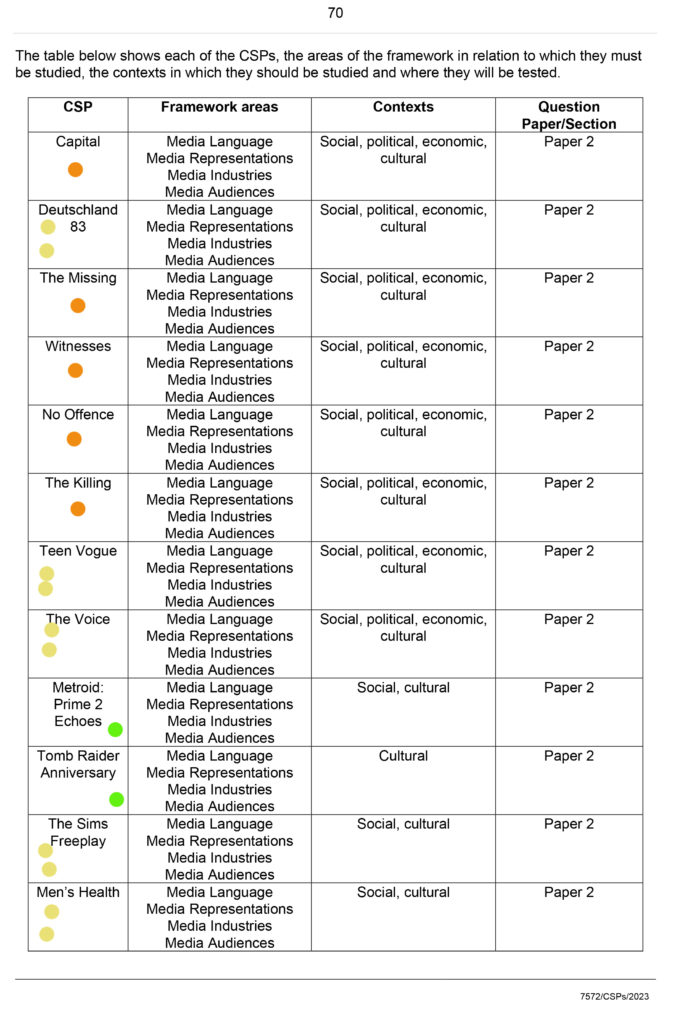
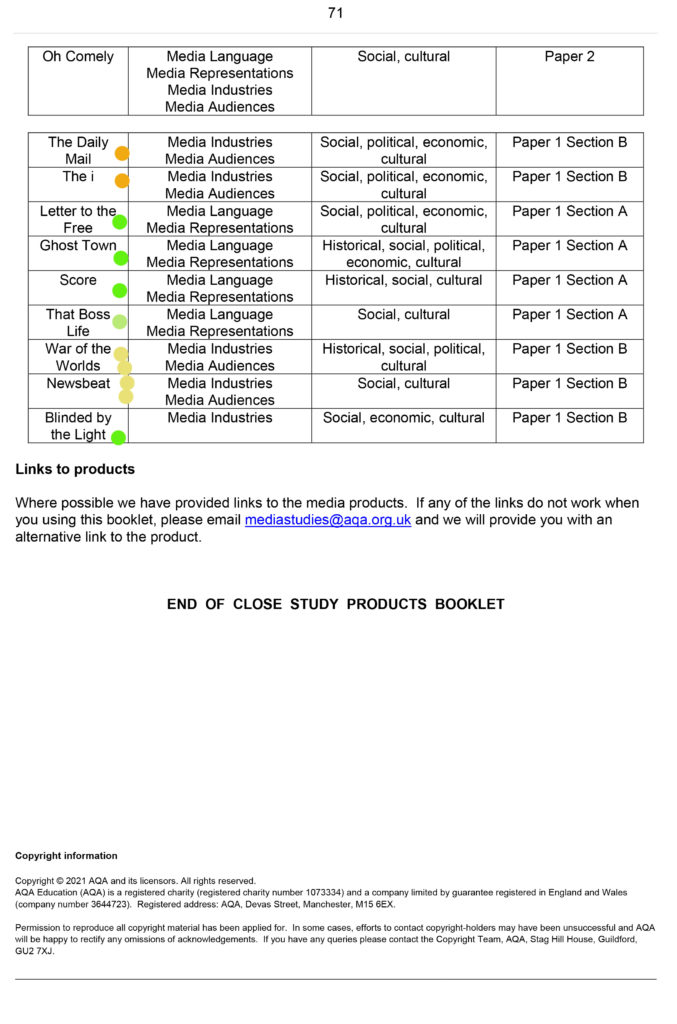
Command Words:
- Describe – Give a detailed account of words.
- Compare- Estimate, measure, evaluate or note the similarity or differences between. Determined similarities and differences between something and the outcome.
- Evaluate- : To determine or fix the value of. To determine the significance, worth, or condition of usually by careful appraisal and study.
- Analyse-Examine something in detail, typically in order to explain and interpret it.
- Knowledge-
- Understanding-
| What Do You Know | Understanding | |
| Noam Chomsky | – five filters- The common enemy, Flak machine, The media Elite, role of Advertising, Ownership. Official sources. – Manufacturing consent -Mass media -Structures of ownership | – Media utilises the common enemy to ignore the real problems. – |
| Jürgen Habermas | – the public sphere | – The public sphere refers too” society engaged in critical public debate”. -The public sphere is an area in social life where individuals can come together to freely discuss and identify societal problems, and through that discussion influence political action. A “Public” is “of or concerning the people as a whole. |
| Semiotics | – The study of signs and symbols and their use or interpretation. | -semiotics theory is that signs do not convey a meaning that is inherent to the object being represented. –Iconic signs – icons are signs where meaning is based on similarity of appearance. –Indexical signs – have a cause-and-effect relationship between the sign and the meaning of the sign. –Symbolic signs – these signs have an arbitrary or conventional link. |
| feminist critical thinking | – Feminist = a political position -Female = a matter of biology -Feminine = a set of culturally defined characteristics -Judith Butler -Laura Mulvey | Judith Butler- “an identity instituted through a stylized repetition of acts”. -Male gaze |
| postcolonialism | -Postcolonialism is about where does our identity come from? How is our identity formed? How do we understand our own identity and how is our identity represented in the local, national and global media? | |
| David Gauntlet | – fluidity of identity – negotiated identity – constructed identity – collective identity. The increase of a pick and mix culture in society is where individuals see options from which they can pick and choose the ones that are a best fit for them. This results in society shifting into a postmodern era whereby economic theory and individualisation rule over our decisions we make. | -He assumed there was a generational divide in attitudes towards gender roles. -post traditional society. |
| Lasswell | – who-sender -says what-message -channel-medium to whom-receiver -with what effect. passage consumption – through propaganda then people believe it -notion of brainwashing -believing what people say. -active and passive | Lasswell’s model of communication (also known as Lasswell’s communication model) describes an act of communication by defining who said it, what was said, in what channel it was said, to whom it was said, and with what effect it was said |
| Lazarfeld | The concept of the ‘two-step flow of communication’ suggests that the flow of information and influence from the mass media to their audiences involves two steps: from the media to certain individuals (i.e., the opinion leaders) and from them to the public. | |
| George Gerber | Cultivation Theory suggests- – Television influences its audience to the extent that their world view and perceptions of the world. ( start reflecting what they repeatedly see meaning TV is considered to contribute independently to the way people perceive social reality. ) – will have an effect on the audience’s attitudes and values. -Long term exposure to violent media makes the audience less likely to be shocked by violence. mean world syndrome- violence is easy to translate, accepting mainstreamed dominant ideology’s. The world is used to violence, all country’s translate things such as humour but violence is the same in all country’s. | Cultivation theory suggests that repeated exposure to television over time can subtly ‘cultivates’ viewers’ perceptions of reality. George Gerbner and Larry Gross theorised that TV is a medium of the socialisation of most people into standardised roles and behaviours. The criticism of this theory is that screen violence is not the same as real violence. Many people have been exposed to screen murder and violence, but there is no evidence at all that this has lead audiences to be less shocked by real killings and violence. media consumption mainstreaming wants the world to believe the same ideologies Shirky believes Gerbners theory is not applicable to modern forms of media. the media has changed and audiences are more active and believes you can no longer talk about users of media products as an audience |
brief 3- product 3.

revision key ideas 1/press
key ideas of the ‘press’ episode that think to media key ideas:
- the abuse of power (who you know ideology) (transformation of the public sphere)
- Rules and regulation. (media laws)
- technology (introduction of new technology’s)
- links between those in power and those who observe. (Chomsky, manufacturing consent)
- the idea of truth and reality. (what is true and false, or based on. morel truth)
Chomsky- manipulation of the public sphere- don’t believe what you see or hear the people in power stand for ‘truth’ but don’t give it. Manipulation of story’s to result in more profit.
holding the elite to account- abusing power (prince Andrew)
Habermas- The rich millionaire being accused of abusing his power. Using their power sexually.
Habermaas’s theory is that the lifeworld is increasingly being taken over by political and economic systems. As politics is about power, attempts at becoming more powerful by politicians and the interests of political parties affects everyday lives. (elite)
brief 2 front cover product

